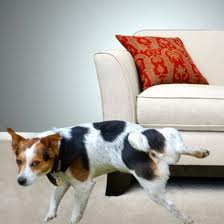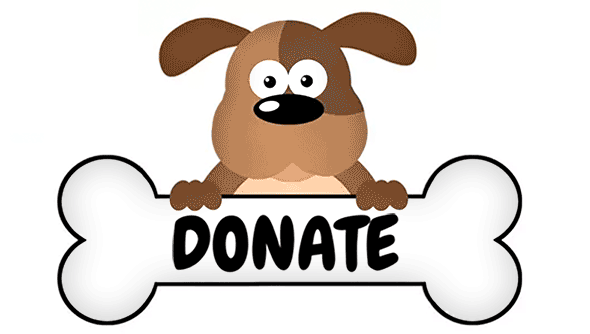
Does your dog urinate on the furniture or walls of your house?
Urine Marking
Urine marking is a normal, instinctive dog behavior, most often in males, particularly unneutered males, but sometimes in females as well. Dogs generally mark on vertical surfaces, and it may be just a few drops. Your dog can relieve himself outside and then still come in and mark. It’s not a housetraining issue as much as a territorial or stress-induced one.
Dogs that mark are not trying to tell us that they’re in charge, and they don’t do it out of spite or anger. It’s more like a calling card that says, “I was here”. Marking is generally a sign of anxiety, rather than dominance. Adding another pet to your household can trigger marking. So can the presence of an animal, like a neighborhood cat or fox, on your property. Anything new – a baby, boyfriend, sofa, shopping bag, visitor’s backpack, even the smell of other animals on your shoes – can provoke marking.
Since medical problems can trigger urine marking, take your dog to the veterinarian to rule out any medical causes first. You could be looking at urinary tract or other infection, incontinence, prostate enlargement, mental confusion, or mobility problems, especially if this is a new behavior in an older dog. Marking can also be triggered by the condition of other resident pets – a female in heat, a dog with a urinary infection, or an intact household pet.
Handling Marking Behavior
Spaying or neutering your dog should reduce marking and may stop it altogether. This should be done before marking becomes a habit that’s more difficult to eliminate.
However, if your dog has been marking for a long time, a pattern may already be established. Because it has become a learned behavior, spaying or neutering alone won’t solve the problem.
Below are other tips:
- Deal with your dog’s anxiety. If your dog is getting used to a new person (baby, boyfriend, guest…), pay lots of extra attention to your dog. Have the newcomer feed your dog, and make sure you give your dog treats or playtime in the baby’s presence.
- Avoid conflict between the pets in your home. Introduce a new pet on neutral territory, and then outside, before coming into the house. Don’t get so excited about your new pet that you neglect your others. And if there is a problem between your pets, get help from a positive trainer or behaviorist before it escalates. Sometimes, the answer is as simple as feeding the dogs in separate rooms.
- Keep unfamiliar items off the floor. Put things in a closet, cabinet, or shelf. Also keep your dog away from new furniture, until it has been around for a while.
- Clean urine marks thoroughly and as soon as possible. Use an enzymatic or bacterial cleaner developed for pet urine, so that the odor doesn’t last. White vinegar will also eliminate urine odor, if it’s used immediately. Even if you can’t smell it, your dog can, and he will return to that same area to pee again.
- Don’t allow access to areas that your dog previously marked. If you can close a door or use baby gates, do it. If that’s impossible, feed your dog in that area, so that he’s less likely to urinate there again.
- Watch for your dog’s signs. Dogs follow a sequence before lifting their leg. Interrupt this sequence before he gets that far. Get him outside, and reward him for urinating there. It may be easier to notice these signs if your dog’s leash is attached to your waist.
- When you can’t supervise your dog, confine him. The best place would be his crate, since he can’t mark there. If your dog doesn’t already like his crate, train him to it gradually, feed him in his crate, and have random treats appear there. If your dog already hates the crate, however, you could try a small room where he hasn’t already marked or an exercise pen, available at any pet store.
- If your dog’s marking behavior isn’t changing, talk to your vet about a short course of anti-anxiety medication. This may calm him enough to make these other methods more effective.
What Not To Do
Don’t punish your pet after the fact by yelling and rubbing his nose in places he has marked.
- Your dog won’t be sure why he is being punished. Is it because he peed? Because he peed near your bed? Because he peed where you can see it?
- Dogs do not associate punishment with something they did earlier – even a minute ago. Your dog has done other things in the last minute, and won’t be sure what he has done wrong.
- Punishing your dog for marking can make your dog confused and possibly fearful. It will make your dog more likely to “sneak off”, or worse, make him afraid to urinate in your presence, even on walks.
Try to think of marking as a way for your dog to communicate.
- “Now that your boyfriend has moved in, my routine has changed, you don’t pay attention to me, and, besides, his backpack smells funny.”
- “Where did this baby come from, and how long is she staying?”
- “What is that fox doing on my lawn? Or is that a giant squirrel?”
- “Why do you let that other dog bully me?”
- “Have you been to that training place again? Your shoes smell like a zillion other dogs!”
And so on…
Resource
Here’s an article on indoor urine marking by Stephanie Colman that was in the “Whole Dog Journal”.
Still Need Help?
Contact Your Dog’s Friend at [email protected] or (301)983-5913 for advice and referrals or check out our list of recommended trainers and behaviorists.
Your Dog’s Friend is a nonprofit 501(c)(3) organization working to improve dogs’ lives, reduce problem behaviors, and keep dogs out of shelters, by educating and supporting their humans.
This material is not intended to be a substitute for professional help when dealing with dogs with intense or potentially dangerous behavior issues. Consult a positive reinforcement trainer or veterinary behaviorist for professional assessment, guidance, and support.




